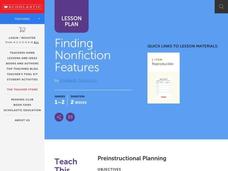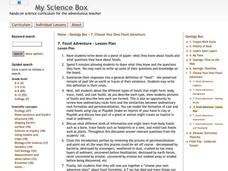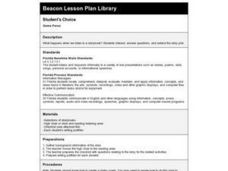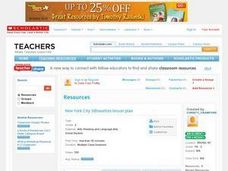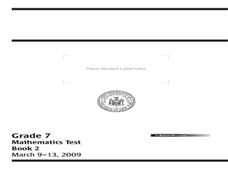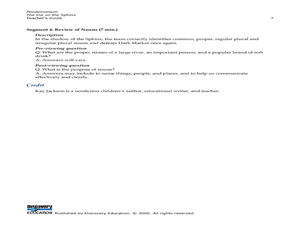Curated OER
Finding Nonfiction Features
Young scholars review the differences between a fiction and non-fiction book. In groups, they use different non-fiction books to identify the eleven features that distinguish it from a fiction book. To end the lesson, they create a...
Curated OER
Fossil Adventure
Students create a book about the process of a dinosaur becoming a fossil. In this earth science lesson, students are taught about fossils and create a book that tells what happened to a dinosaur's bones after they die.
Curated OER
Sorting Out Homophones in Roald Dahl's
Students explore the concept of homophones. In this homophone lesson, students use a selection from the book Matilda to review homophones. Students use a web to identify homophones.
Curated OER
Lesson 6 - Quotation Marks
Students complete activities with the book Sarah Plain and Tall. For this literature lesson, students read, discuss, and review vocabulary from Chapter 6. They make a list of quotations and review how to use quotation marks.
Curated OER
Spider Body Parts
Students identify spider body parts. In this arachnid lesson plan, students review the story Amazing World of Spiders and discuss the various spider body parts. Students fill in the correct body parts on a copy of a blank spider...
Curated OER
Different! Diverse! Dynamic! What Do Stories Share?
Students compare and contrast the stories, "Leo, the Late Bloomer," and "Thank You, Mr. Falker." They develop a Venn diagram, and write and illustrate the central theme of the stories.
Curated OER
Linking Up the Food Chain
Students to the book, Life in a Pond, then discuss the food chain and create a food chain mobile. On one strip of paper students draw and label a pond plant, on another a tadpole, on another a fish and on the last a person.
Curated OER
STUDENT'S CHOICE
Students interact, answer questions, and extend the story plot. They write a Haiku or basic poetry with their words, name characters, create a new ending for a story, and write a new story with one of the characters.
Curated OER
Nomenclature Worksheet
In this chemical compounds worksheet, students write the correct chemical name for the given formulas and then write the correct chemical formula for the given compounds. This worksheet has 30 problems to solve.
Curated OER
Neighborhoods
Students examine homes around the world. In this multicultural instructional activity, students read the book A World of Homes and Homes Around the World. Students compare and contrast the homes in the books to their own homes. Students...
Curated OER
Silouettes of New York City
Second graders create a New York City silhouette. In this visual arts lesson, 2nd graders view the picture book, Uptown, and identify the silhouettes. Students use construction paper, paint, and a flashlight to create artistic...
Curated OER
NY State Testting Program
For this algebra worksheet, 7th graders review and practice core concepts for their 7th grade exam. They review geometry, algebra and solving word problems. This assignments contains a booklet of worksheets.
Curated OER
For Your Dining Pleasure
Students share opinions about their favorite ethnic dishes. They research the cuisine of another culture and write a review of a local restaurant that features that cuisine.
Curated OER
Ralph Ellison
Students read and analyze the novel, "The Invisible Man," by Ralph Ellison. They participate in class discussions, write an essay, and in small groups create a multimedia essay on a group that they consider socially "invisible."
Curated OER
Philanthropy News
Students collect examples of local philanthropy and write a news article for a local newspaper. For this philanthropy lesson, students read Helping Out by George Ancona to gain understanding of what philanthropic acts are. Students...
Curated OER
Real-World Reasonableness
Fifth graders apply math to real-world situations. In this mathematics lesson, 5th graders are read the book, "Math Curse," which discusses ways in which math is used each day. Students then write a sequel to the book in groups,...
Curated OER
Be A Perfect Person in Just Three Days
Students read a chapter in a book. In this reading comprehension lesson, students share their predictions of chapter 6 of the book Be A Perfect Person in Just Three Days, learn new vocabulary words, read chapter 6 and complete a...
Curated OER
Harriet Tubman: An Informative and Impressionistic Look
Students examine artwork depicting Harriet Tubman. In this Harriet Tubman lesson plan, students review her life and how she impacted the Underground Railroad. Students view impressionistic artwork showing her life. Students then create...
Curated OER
Edward Lear, Limericks, and Nonsense: There Once Was...
Students recognize poetic devices including rhyme, syllabification, and meter. They identify the characteristics of a nonsense poem and of a limerick. They write their own limericks.
Curated OER
Holidays and Observances: Looking at Diversity and Culture
Learners share their own knowledge and experiences of holidays they observe. They research a holiday of their choice and write a report. They also create art of their holiday to complete as a pre-writing activity.
Curated OER
Rudolfo Anaya
Students read and analyze the Rudolfo Anaya novel Bless Me, Ultima. They discuss passages from the book, watch a video, view and analyze a mural of Mexican American artwork, and write a journal response.
Curated OER
ADULT ESOL LESSON PLAN--Transportation and Travel
Students, after defining a list of vocabulary words on the board, review and identify basic types of transportation (bus, taxi cab, car, plane, and ship) in the United States. In addition, they make a graph of all the different ways that...
Curated OER
Activity Plan 3-4: Scrumptious Shapes
Students discover together that shapes are everywhere - even in the food we eat. In this early childhood math and art lesson, students read about shapes, identify foods that match geometric shapes, and create a class book.
Curated OER
Pendemonium - The Ink on the Sphinx
Students define and identify nouns. In this nouns instructional activity, students watch a video and review proper and common nouns before constructing a noun pyramid. They present their noun pyramids to the class and add them to a...


